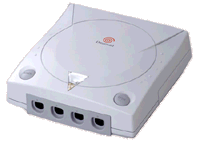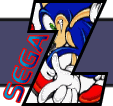 For licensed developers of games for the Sega Dreamcast home video game system, the Microsoft® Windows® CE operating
system with the DirectX® API provides a flexible, optimized development environment supported by the Microsoft Visual
C++® development system that eases title development and provides true cross-platform compatibility with Windows-based
PCs.
For licensed developers of games for the Sega Dreamcast home video game system, the Microsoft® Windows® CE operating
system with the DirectX® API provides a flexible, optimized development environment supported by the Microsoft Visual
C++® development system that eases title development and provides true cross-platform compatibility with Windows-based
PCs.
The Windows CE operating system with DirectX for the Sega Dreamcast system brings the benefits of an advanced,
powerful and flexible Windows-based development environment to the world of console game development for the
first time.
Develop Games That Are Cross-Platform-Compatible With the PC
Windows CE with DirectX allows developers to amortize rising development costs by developing
Dreamcast games that are source-code-compatible with the PC. Using Windows CE, developers will
be able to create cross-platform titles more efficiently by taking advantage of the well-established
Win32® and DirectX APIs that are source-code-compatible with the Windows operating system on the PC.
All Win32 and DirectX APIs are subsets of the Windows NT® operating system, Windows 95, Windows 98
and DirectX 5.0, making it relatively easy to port a Dreamcast game to the Windows desktop platform
and vice versa.
Develop in an Environment Optimized for Console Performance
Windows CE with DirectX has been hand-tuned to be small and fast to provide superior performance
specifically targeted at the Sega Dreamcast hardware architecture. The operating system has been
streamlined for size, removing unnecessary services such as the graphical user interface (GUI) and
providing only those APIs required for games. All parameter validation has been removed to reduce
overhead, all critical loops are coded in assembly, and SH-4-specific features are utilized,
including vector/matrix instructions. In addition, DirectX 5.0 for Windows CE has been specifically
targeted at, and optimized for, Dreamcast's hardware, such as the PowerVRII, Yamaha AICA audio
subsystem, and Sega game controllers and modem.
Take Advantage of Operating System Services and Familiar, Flexible Libraries
Windows CE with DirectX saves time on game development by providing key services, including input,
sound and 3-D graphics, as well as memory and CD file management, dynamic-link libraries and
multithread synchronization. Built-in support for standard Internet protocols, Window Sockets and
the DirectPlay® API facilitate taking advantage of Dreamcast's networking capabilities for Internet
access and networked multiplayer gaming. The modular architecture of Windows CE allows flexibility
in the use of libraries and services. If a developer wants to use his or her own proprietary set of
libraries, a driver development kit is available to allow substitution of custom components.
Use the Same Great Microsoft Development Tools Available for Windows
Windows CE with DirectX allows Dreamcast developers to create console games utilizing the
productivity and convenience features of the same powerful integrated development environment (IDE)
used by developers for Windows. The development tools provided with the Dreamcast system's Windows
CE Software Development Kit (SDK) are built around Microsoft Visual Studio™ development system with
well-tested and refined Visual C++-based tools that, over the course of their history, have been
extensively tested, documented, enhanced and refined, becoming one of the most powerful and
feature-rich development environments available.
Core Windows CE Operating System Components
- Kernel - Supports pre-emptive multitasking and multithreading with priority-based
scheduling. Manages system resources such as physical and virtual memory and MMU. Provides loader
and service interrupts.
- Communications - Supports a subset of the Windows Sockets and RAS APIs, providing TCP and UDP
sockets and PPP dial-up.
- File system - Provides access to Sega's CD-ROM and designed for maximum performance.
ISO9660 Level 2-compliant. Supports memory-mapped files and asynchronous I/O. Designed to allow the
developer to fill the CD-ROM pipeline for better streaming performance.
- Minimal USER and GDI APIs - Support loading and copying bitmaps, rendering text or
DirectDraw® API-based surfaces, input and message handling, string resource loading, and the
Rectangle APIs. Other functions such as window management and cursors have been eliminated.
- Japanese language support - IMM/IME support available (game responsible for providing
user interface for accessing system-level IME support).
- Persistent Storage API - Very lightweight and block-oriented new API to manage NVRAM
cards. Desktop version is also provided for emulation.
- C-Runtime Library - Provides standard C utility functions, string manipulation, math,
exception handling, file I/O, and memory allocation.
DirectX Components
- DirectDraw - Provides 2-D graphics facilities, including video memory management and
palette management. Supports full-screen exclusive mode only.
- Direct3D® - The Direct3D API Immediate Mode supports transformation, lighting and
rendering of 3-D graphics primitives.
- DirectSound® - Supports digitized sound input and output. Interfaces with Sega ARM
code to manage Dreamcast sound memory.
- DirectPlay - Supports Internet and modem communications for multiplayer gaming. Provides
APIs to enable online chatting, the sending and receiving of messages, and maintaining game state
among all players.
- DirectInput® API - Interfaces to Dreamcast game controllers.
- DirectShow™ API - Supports digital audio and video playback and synchronization.
MPEG1 encoded AVI playback is also supported.
Tools Components
- Visual C++ - Works within the Visual Studio development system IDE, offering the ability to edit,
compile, link, execute and debug programs from within a single application.
- Windows CE Toolkit for Visual C++ 5.0 - Includes optimized SH-4 compiler and tool set.
- Windows CE and DirectX SDK - Provides libraries, headers, run times, samples and docs for building games.
- SH-4 Compiler - Compiles and debugs within IDE. Optimized to exploit SH-4 features. In-line assembler
support and SH-4 assembler also provided.
- Debugging support - Source-level, integrated Visual C++ debugger that supports emulation on PC or remote
debugging on target hardware. Provides GUI and features of Visual C++ debugger.
- Driver development kit - Allows development of custom Windows CE system-level components.
|



 For licensed developers of games for the Sega Dreamcast home video game system, the Microsoft® Windows® CE operating
system with the DirectX® API provides a flexible, optimized development environment supported by the Microsoft Visual
C++® development system that eases title development and provides true cross-platform compatibility with Windows-based
PCs.
For licensed developers of games for the Sega Dreamcast home video game system, the Microsoft® Windows® CE operating
system with the DirectX® API provides a flexible, optimized development environment supported by the Microsoft Visual
C++® development system that eases title development and provides true cross-platform compatibility with Windows-based
PCs.